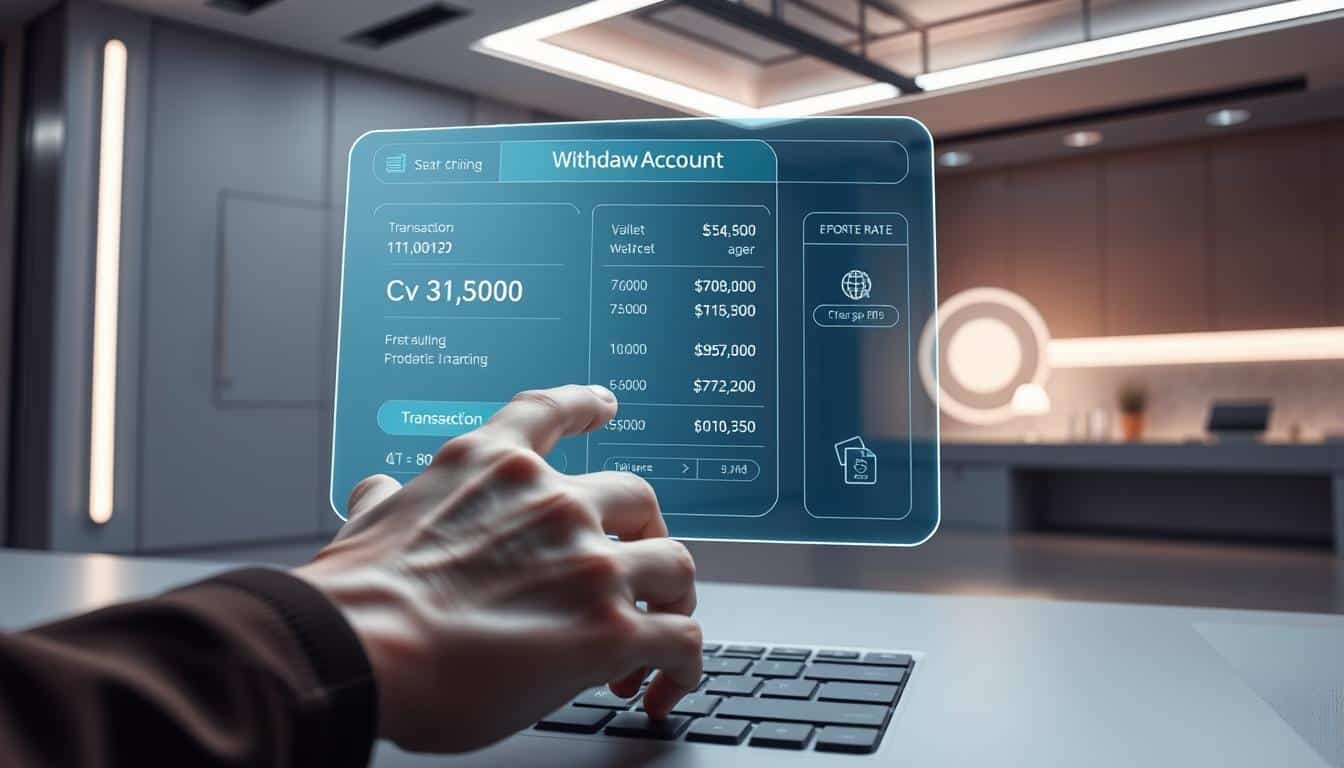Most on-chain confirmations for some platforms finish in less than five minutes. But, this does not mean you can get your cash instantly. I’m here to give you real tips on turning your crypto into cash and putting it into a U.S. bank. You’ll learn each step of the way, including troubles I faced.
Services like Crown88 offer a wallet that handles many currencies and lets you convert them on the platform. Others, similar to ZA Miner, give daily USD payouts. These methods show how cashing out crypto can be easy. Yet, they rely on KYC/AML checks, banking systems, and foreign exchange policies. These can all change due to politics and new rules.
In this article, you’ll get a step-by-step guide: learn about withdrawals, set up your accounts, make the transfer, and handle any delays or fees. I’ll share tech tips and lessons I learned the hard way. This includes things to watch out for and tricks to make the process faster.
Key Takeaways
- Not all crypto-to-bank transfers are equal: on-chain speed and fiat payout timing differ.
- Platforms with in-wallet conversion cut steps but still require KYC/AML verification.
- Expect bank processing, FX impact, and possible holds—especially for large transfers.
- Prepare your exchange and bank details ahead to avoid rejected transactions.
- Use tools like wallets and tax calculators to track timing, fees, and reporting needs.
Understanding Cryptocurrency Withdrawal
Moving crypto to cash is simpler than it seems. The key step is turning digital value into actual money and sending it to a bank account. You can sell on an exchange, use a wallet that lets you cash out, or make a peer-to-peer sale and then transfer to a bank.
What is Cryptocurrency Withdrawal?
Withdrawal means changing digital coins into real currency and putting that money in a bank account. I like using Coinbase or Kraken to sell, then I get the money through an ACH transfer to my bank.
There are different ways to do it. Some apps let you swap and transfer funds directly. Or, you can sell to someone directly and get the money in your bank. Each option affects how quick and costly the process is.
Why Withdraw to a Bank Account?
People cash out for regular expenses or to rebalance their investments. I withdraw to pay bills and because banks keep the money safe, unlike many crypto wallets.
It’s also about spending the money. Most businesses prefer regular money, so moving your crypto to a bank makes it spendable. For those mining crypto, getting daily cash into a bank is usually the goal.
Common Misconceptions About Crypto Withdrawals
Withdrawals aren’t always quick. The speed depends on the method and the bank’s process.
People often get the fees wrong. You’ll pay for the network and the bank or exchange. And surprise, KYC checks are common — they confirm your identity before letting you move money.
Based on what I’ve seen, expect checks and be aware of the entire process. Laws and global events might also affect how and where you can send your money.
Preparing for Withdrawal
I always follow a brief ritual before I move funds from an exchange. It make things faster and avoids errors that could halt transfers. Below I’ll share the steps I take to safely transfer crypto to my bank account.
Checking Your Exchange Regulations
First, check the withdrawal policies for your location on the exchange. Look out for any withdrawal caps, accepted payment methods like ACH, SEPA, and wire, and required KYC processes. One time, I found an exchange that asked for an ID, an address proof, and a selfie to allow money withdrawals. Some places might not allow users from certain areas. Make sure to know the least amount you can pull out and if your bank is directly supported.
Verifying Identity and Security Features
Turn on two-step verification and check the bank account linking procedure. Platforms might use small deposits or services like Plaid to make sure it’s really you. Not completing KYC is a common reason why withdrawals don’t go through. Also, finish any needed verification ahead of time if you wish to withdraw large amounts.
Ensuring Sufficient Funds in Your Account
Work out all the fees before you hit withdraw. Remember to include network fees, rate differences, and the platform’s own minimums. Don’t forget to see if your bank can handle the money and any possible holds. Even services that allow quick payouts need time to process. I always keep a little extra in my account for any surprise charges.
Here’s my personal checklist:
- Screenshot of completed KYC and the time
- Double-check of my bank’s routing and account numbers
- Calculation of all potential fees and rate differences
- Record of the transaction ID or similar codes
- Remembering the expected time to complete the transfer
Following these steps smooths out moving digital money to a bank account. Proper planning and using smart withdrawal methods cut down on wait time and stress.
How to Withdraw Crypto to Your Bank Account
I talk about turning crypto into cash and putting it in bank accounts a lot. Below, I’ll guide you through the steps. I’ll also compare methods to help you pick the best way to cash out your crypto.
Quick overview
Here’s how you withdraw crypto to cash: choose how you’ll do it, sell the crypto for cash, ask your bank to pull the cash in, then check the deposit made it. I make sure to double-check bank info and save every transaction ID. This helps with taxes and keeping track of money.
Step-by-step withdrawal process
1. Pick a way to do it: sell directly on an exchange, change it in a wallet, sell to someone directly, or use a service that does payment processing.
2. Exchange your crypto for cash. Use platforms like Coinbase, Binance, or Kraken and choose USD to get your money.
3. Start pulling your cash out using ACH, domestic wire, or instant transfer.
4. Check your bank for the deposit and match it up. Keep all receipts and IDs for when you do your taxes.
Different withdrawal methods explained
Exchanges like Coinbase make it easy to turn crypto into cash directly. They work well with U.S. banks. International options include Binance and Kraken, which vary in fees and steps needed.
Some wallets can automatically change your crypto to cash and send it to your bank. This can save time but you may still need to verify your identity.
Peer-to-peer places let you sell directly to others. This might skip some steps, but there’s more risk and waiting for bank transfers can take longer.
Using payment processors or crypto cards gives quick access to spend your cash. Watch out for fees, limits, and restrictions these options come with.
Comparing fees of different exchanges
Fees can add up from various places: moving crypto, trading on exchanges, taking money out of platforms, and bank charges. I try to add up all costs before I trade.
| Method | Typical Fee Types | Median Time | Notes |
|---|---|---|---|
| Coinbase (direct sell + ACH) | Trading spread, fixed or percent fiat withdrawal fee, ACH processing | 1–3 business days | Strong U.S. rails, simple UX |
| Binance / Kraken | Trading fees, withdrawal charge, possible wire fees | Same day to 3 days | Good global liquidity; bank fees vary |
| In-platform universal wallet | Conversion fee, lower on-chain gas if native flow | Minutes to hours | Fewer manual steps; KYC required |
| P2P marketplaces | No platform fiat fee sometimes, bank incoming fees possible | Hours to days | Counterparty risk; bank transfer delays common |
| Payment processors / crypto cards | Conversion fees, card issuer fees, cash-out caps | Instant to 1 day | Best for immediate spending; not ideal for large withdrawals |
I keep track of how long each method takes and total costs. When it comes to converting Bitcoin to cash, I prefer exchanges that show all their fees clearly. Some promise lower costs or clear payouts, like Crown88 and ZA Miner, but I always check the total cost before I move money.
Pro tip: Combine all costs, including network, exchange, and bank fees, to get the full price of withdrawing. Knowing this helps avoid unwelcome surprises during the cash-out process.
Popular Cryptocurrency Exchanges for Withdrawals
I’ve tried cashing out on big platforms. I noticed differences in speed, fees, and how they connect with banks. Picking the right exchange affects how easy it is to move digital money to a bank. Here’s a guide on what to expect from popular exchanges when you’re withdrawing to your bank.
First is Coinbase, a top choice for people in the U.S. It lets you transfer money through ACH and instant card withdrawals if possible. The system is easy to use, follows strict KYC/AML rules, and is a favorite for its simple way to take out cryptocurrency.
Binance is great for global traders and offers a lot of liquidity. If you’re in the U.S., go for Binance.US if it’s available. In some places, it’s faster for getting money in and out, but the banks you can use vary by local laws. It’s a good pick when you need speed in withdrawals.
Kraken is known for bank wires and trading between fiat and crypto. It’s better for large transactions and people who go through higher verification levels. It’s secure and has strong controls for withdrawals, making it safe for moving big sums.
The user experience on platforms is really important. Having one wallet for everything and simple withdrawal steps means fewer mistakes. I’ve noticed that wallets accepting multiple currencies make converting and withdrawing simpler, cutting down on unexpected issues.
The costs can change depending on where and how you withdraw. Look at the fees for turning stablecoins into USD, the fixed fees for taking out money, and differences in trading costs before you commit. Comparing these fees will help you find the most cost-effective way to withdraw your cryptocurrency.
| Exchange | Common Bank Rails (U.S.) | Best For | Typical Withdrawal Methods | Notes on Fees |
|---|---|---|---|---|
| Coinbase | ACH, debit card (instant in some cases) | Everyday consumers, simple cash-outs | ACH transfer, instant card payout, stablecoin conversion | Low ACH fees, possible instant-card fee and conversion spreads |
| Binance / Binance.US | Bank transfer options vary by region | Active traders, users needing liquidity | Bank transfer, P2P in some markets, stablecoin rails | Competitive spreads, variable flat withdrawal fees |
| Kraken | Bank wires, ACH depending on region | High-volume withdrawals, advanced users | Wire transfer, ACH, fiat pair conversions | Wire fees; lower conversion rates for verified tiers |
When trying this out, start with small withdrawals. Make sure your bank accepts the transaction methods and be ready for identity checks on your first transfers. Doing this makes withdrawing to a bank smoother and avoids unexpected problems when using these methods.
Key Statistics on Crypto Withdrawals
I closely monitor on-chain flows and exchange reports. The year 2025 saw more people turning their profits into real money. This is seen in both daily outflows and reports from platforms, especially when the market jumps.
I’ll discuss important numbers and trends about changing crypto into cash. This also covers moving money to bank accounts.
Recent Growth in Crypto-to-Fiat Transactions
In 2025, more people got into Ethereum, raising the number of times they switched to cash. Exchanges like Coinbase and Kraken saw more cash being taken out on good days. This boom was helped by shops and traders using crypto more.
Banks and special desks saw larger cash withdrawals by big players. This increase, especially when the market is wild, pushed up the total cash conversions from crypto.
User Demographics in the U.S.
Young, tech-savvy folks in cities like San Francisco and New York are often withdrawing. They usually go for bank transfers to keep things clear with taxes and liquidity.
Individual investors are a big part of the market. But institutions dealing through banks or OTC routes are moving more money, affecting fees on big platforms.
Predictions for Future Trends
I see more people turning crypto into cash as DeFi tools get better. This and new bank ties could make withdrawals quicker and easier.
World events might open new ways to move money. This could shift how people transfer money to banks, especially outside of the usual routes focused on the U.S. dollar.
| Metric | On-Chain → Exchange → ACH | Instant Bank Link | Wire Transfers |
|---|---|---|---|
| Median Time | 6–24 hours | minutes | 1–3 business days |
| Typical Fee Range | $1–$10 | $0–$5 | $15–$50 |
| Common Use Case | Lower-cost retail withdrawals | Fast access for spending | Large institutional settlements |
Tools to Assist with Crypto Withdrawals
I have a small toolkit for each withdrawal. Over time, I narrowed down some must-haves. They make getting cash from crypto less of a headache and easier to track. Below, I’ll share what I use and why they are important.
Crypto wallets
I keep long-term crypto in hardware wallets like Ledger or Trezor until it’s time to sell. This cuts down online risks and limits what hackers can get if they hit an exchange.
For daily transactions, I use Coinbase or Kraken’s exchange wallets, or Exodus for quick trades. I only move the amount I’ll change into cash, not the whole wallet. This simple step cuts risks and saves on fees.
Currency converters
I use live currency converters to figure out cash amounts before selling. I compare rates on CoinMarketCap, CoinGecko, and in-app converters on Binance or Coinbase.
Independent converters help when mining pays out in daily USD amounts. They help me double-check exchange rates and spot price drops fast. I see them as a reality check, not the final numbers.
Tax calculation tools
Crypto tax tools automate the math for gains and losses and can pull history from exchanges through API or CSV files. I rely on CoinTracker and Koinly to prepare for tax season in the U.S.
These tools make me match up bank records with exchange withdrawals. This habit saves me time during tax season and creates a record trail for the IRS.
Before any withdrawal, I use a secure hardware wallet, choose an exchange with reliable cash options, check conversion rates, and sort out taxes with crypto tools. This process ensures safety and accuracy.
| Tool Type | Example Brands | Primary Benefit | When I Use It |
|---|---|---|---|
| Hardware Wallet | Ledger, Trezor | Offline custody; private-key safety | Long-term storage; prior to planned sales |
| Exchange/Software Wallet | Coinbase, Kraken, Exodus | Quick conversion; fiat rails | When I need fast withdrawals to bank |
| Currency Converters | CoinMarketCap, CoinGecko, in-app converters | Real-time price checks; slippage control | Before selling; to verify payouts |
| Tax Tools | CoinTracker, Koinly | Automated gain/loss, IRS-ready reports | Pre-withdrawal planning; year-end filing |
Potential Withdrawal Fees and Costs
I’ve looked into withdrawal fees on Coinbase, Kraken, and Binance. Each has different charges based on the method, currency, and location. Knowing these helps align your expected profits with reality before you withdraw.
Understanding Exchange Fees
When you sell crypto, exchanges take a cut through trading spreads and maker/taker fees. They may also charge a fee to convert crypto into USD. Additionally, there could be a flat or percentage fee for transferring money via ACH or wire.
Before selling, see Coinbase and Kraken’s fee schedules. From what I’ve seen, adding a 1–3% buffer should cover unexpected fees when moving crypto to your bank.
Bank Processing Fees Explained
Banks might charge you for incoming wires or for intermediate bank fees on international transfers. ACH transfers are cheaper but take more time. Also, if there’s a limit on how much you can receive, your transfer might need additional review, costing more.
Check with your bank on fees for processing crypto withdrawals. This will help decide whether a wire or ACH transfer is better for you.
Hidden Costs Users Might Encounter
Withdrawing to a non-USD account involves FX conversion spreads. Sometimes, temporary holds could lead to extra conversion steps. Also, on-chain gas prices might increase just before you sell.
Don’t forget taxes or unusual withholdings might eat into your returns. I suggest setting aside a 1–3% cushion for unexpected fees and exchange rate changes. This small step can help avoid shocks later.
Common Challenges When Withdrawing
I often face problems when turning crypto into cash. Small errors can quickly pile up. I’ll share common issues and how I deal with them.
Withdrawal Limits and Restrictions
Places like Coinbase and Kraken have daily and monthly limits based on your account level. Banks might block transfers from certain places or large amounts. I plan big withdrawals in advance and break them down if necessary to avoid these limits.
Some users can’t transfer money because of where they live. Platforms might delay big transfers for extra checks. If you’re planning to withdraw a lot, let support know and have your documents ready.
Processing Times and Delays
How long it takes to get your cryptocurrency into cash varies. Some transactions are quick, like Solana’s, while bank transfers can take days.
Some services allow nearly daily cash outs. Always check how long transfers take, especially around weekends and holidays.
Dealing with Rejected Transactions
If your withdrawal doesn’t go through, start with the basics. Double-check your bank details and the name on the account. A mismatch or missing info often leads to problems. And unusual transaction patterns can trigger security alerts.
After a rejection, exchanges usually refund you, minus any fees. Keeping records of transactions helps solve issues faster. If there’s a hold, having proof of your fund’s origin helps clear things up.
Here’s my pre-withdrawal checklist:
- Make sure your account level supports the amount you want to withdraw.
- Double-check bank details before transferring.
- Inform exchange support about big withdrawals in advance.
- Keep a record of transaction IDs and screenshots.
How to Ensure a Smooth Withdrawal Experience
Learning early helps to move crypto to a bank smoothly. Planning, small tests, clear records, and right timing reduce stress. Here are steps I follow with platforms like Coinbase, Kraken, and Binance.US to dodge common troubles.
Best Practices for a Secure Withdrawal
Finish KYC before moving funds. Exchanges limit new accounts. Being verified quickly removes these caps.
Try a small withdrawal first to check details. This method once helped me detect and fix a mistake swiftly.
Secure accounts with 2FA and a hardware key if you can. Keep records of transactions and bank confirmations safely for any future checks or issues.
Trust platforms like Coinbase, Kraken, or Binance.US and credible payment processors. These are key practices for safely withdrawing crypto.
Monitoring Transaction Status
Use blockchain explorers to watch transactions using the hash. This tells you when a transfer is final.
Keep an eye on exchange withdrawal screens for updates. Look at emails for any notices. Use in-app indicators if available.
Lacking an in-app tracker, use a blockchain explorer with your transaction hash. This is essential in my process for keeping tabs on withdrawals.
Keeping Track of Important Deadlines
Plan your withdrawals on bank days. Avoid starting them late Fridays or before holidays to prevent delays.
Remember cutoff times for ACH and wire transfers. This influences when you see your money.
Consider tax dates. In the US, moving crypto counts as a taxable moment. If you’re near tax times, it might be smart to talk to tax experts or use tax tools for guidance.
Frequently Asked Questions (FAQs)
I often get asked similar questions about moving crypto to a bank. I’ll share what I’ve learned from Coinbase, Kraken, Binance, and others. My advice is brief, straightforward, and helpful.
Can I withdraw to any bank account?
You can’t always do this. Big exchanges need your bank name to match your profile. It helps prevent fraud and quickens checks.
Some banks, like Chase and Wells Fargo, might not accept money from crypto. They have rules that could cause delays or need more checks. Using peer-to-peer transfers seems good but is risky and might break rules.
How long does the withdrawal process usually take?
Withdrawal times vary. On-chain transfers might be fast if the network and fees are right. But moving money to a bank often takes longer.
Withdrawing through ACH can take 1–5 days. Domestic wires can be quicker, sometimes the same day, if you make the bank’s deadline. Some platforms offer quick fiat money access, while others may delay for checks.
Are crypto withdrawals taxable?
Yes, in the US, turning crypto into cash can mean you owe taxes. The IRS views crypto as property, so you report gains or losses.
Track your buy dates, prices, and how much you put in the bank. Tools from CoinTracker or TurboTax can help with taxes, and see a CPA for big or complex deals.
Evidence and Statistics Supporting Crypto Withdrawals
I closely follow market trends and user stories. Recent 2025 data show a strong ETH demand, driven by DeFi and big investors. This change has increased conversions on platforms and made it easier to change crypto to regular money.
I will share main findings, examples of platforms, and how rules affect them. I want to show how these changes help you get cash from your crypto.
Recent research findings
Studies this year show more liquidity and higher volumes of cashing out. Platforms with scheduled payments have seen more stable cash withdrawals. This pattern proves crypto withdrawals work well in practice.
Platforms with daily payouts offer a smooth experience for users. Data shows these providers have fewer withdrawal problems and settle transactions quicker.
Case studies converting crypto to cash
Crown88 fully integrated crypto with personal wallets and quick updates. They have fewer customer issues and faster cash payments because of this.
ZA Miner has a daily payout system in USD, showing it can handle large volumes. Users get their money reliably and with fewer mistakes.
These cases show how to effectively turn crypto into cash. They offer patterns for others to follow in creating efficient cashing processes.
Impact of regulation changes on withdrawals
Changes in global politics and rules affect how money is moved and what currencies are used. Regulations change which banks can be used and the level of checks needed.
Exchanges update their policies to keep up with these rules. These changes can quickly alter where and how users can withdraw money.
Key points: more evidence supports crypto withdrawals, real examples show how to convert crypto to cash, and keeping an eye on regulations is crucial.
Conclusion and Final Thoughts on Withdrawals
I explained how to move cryptocurrency to real money and the choices you’ll need to make. You should get your KYC papers ready, choose how you’ll take out your money—using services like Coinbase, Binance, Kraken, an in-app wallet, or peer-to-peer. Think about fees and how long it takes, and keep track of everything for taxes. Trying a small transaction first can help you avoid surprises and check your account’s details and limits.
Summary of Key Points
To start, make sure your identity is verified and pick the best service. Compare fees and keep an eye on your transaction. Before you send your money, use tools to figure out how much you’ll get after fees. Good exchanges and special wallets make it easier to get your money in cash. Also, new payment options and wallets built into apps are making things smoother for everyone.
Future Outlook on Crypto Withdrawals
As more money moves in crypto and businesses get involved, cashing out will become more common. Yet, how this works will depend a lot on new rules. Fast tools for changing currency and wallets that hold many types of money will probably make things easier. When planning your money moves, think about changes in rules as a risk and adjust how you take out your money as needed.
Here are my final tips on moving crypto to your bank: start with a small amount, double-check everything, and be ready for taxes and possible hold-ups. The information and tools we talked about will help you choose the best way to get your money, considering how fast you need it and what risks you can take.








